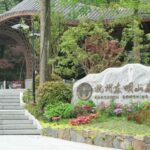The Water Level Stele is located on the west side of Zhenming Road at Pingqiao Street in Haishu District, Ningbo City (formerly known as Pingqiao River). It was established during the Baoyou period of the Song Dynasty (1253-1258) and was further repaired during the Ming and Qing dynasties. Most of the stone pavilion structures that stand today were built during the reign of Emperor Daoguang in the Qing Dynasty, preserving the foundation of the Southern Song Dynasty and the Ming Dynasty’s rebuilt ‘Ping’ character stele.
The Water Level Pavilion was constructed for the Water Level Stele. Situated under the Siming Bridge, it was chosen for its moderate location to measure the water level. The character ‘Ping’ was engraved on the stone, and the sluice gates outside the city were operated based on the visibility of ‘Ping’. When the water covered the ‘Ping’ character, it was time to release the water; when the ‘Ping’ character was visible, it was time to store water. Proper operation of the sluice gates ensured that the people were free from the worries of droughts and floods. As a result, Siming Bridge was renamed Ping Bridge.

The Water Level Pavilion played a significant role in ensuring abundant harvests and the safety of the region. The Water Level Stele, using the principle of water leveling, achieved the purpose of assessing disasters and unifying the调度 of the people, making it the only example among ancient urban water conservancy relics in China. It is a rare physical evidence for the study of the history of water conservancy development and the study of urban flood prevention and drainage water conservancy projects, holding special significance. The site is open all year round, accessible at all times.

The Da Yun River Water Level Stele
The Water Level Stele is located on the west side of Zhenming Road at Pingqiao Street in Haishu Dist[...]









